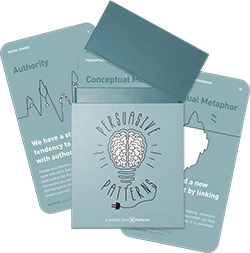Appointment Dynamic
Design Pattern
Problem summary
Force users to return at a set time to take a specific action and claim a reward
Usage
- Use when you want to create a habitual loop where users keep coming back for more
- Use when you want to split up larger tasks into fewer to limit cognitive load
- Use to ask small first and larger, later
This card is part of the Persuasive Patterns printed card deck
The Persuasive Patterns Card Deck is a collection of 60 design patterns driven by psychology, presented in a manner easily referenced and used as a brainstorming tool.
Get your deck!Solution
Reward those who return and punish those who fail to re-engage on time.
- Create traditions. Let the time and place to come back recur over fixed time schedules, i.e. every Tuesday, first day of the month, or similar. This will make it easier to remember and commit to – especially for groups and social contexts. “Happy hour” is a great example.
- Penalize no-shows. Make it clear that not showing up at the set time will have negative consequences, just as showing up will have positive ones. In the game Farmville, your crops will vanish upon inaction.
- Set a new appointment. Once the user comes back, make sure that it is very explicit when they need to be back again, before leaving.
Rationale
The appointment dynamic provides reason and immediacy for the user to come back. Making the action required- and the window to take the action explicit can help create a sense of urgency as it becomes clear when the reward will be harvested or missed. Appointment dynamics are often tied to reward schedules that motivate frequent action.
The Appointment Dynamic concept is not rooted in academic research but discovered in the commercial space as a persuasive recipe combining multiple persuasive ingredients into one powerful mixture. Seth Priebatsch proposed the recipe in his “SCVNGR Secret Game Mechanics Playdeck”.
1 SCVNGR’s Secret Game Mechanics Playdeck at TechCrunch
2 Selecting Persuasive Strategies and Game Design Elements for Encouraging Energy Saving Behavior
3 Welcome to the Decade of Games by Seth Priebatsch at Havard Business Review
User Interface Design Patterns
- Forms
- Explaining the process
- Community driven
- Tabs
- Jumping in hierarchy
- Menus
- Content
- Gestures
- Tables
- Formatting data
- Images
- Search
- Reputation
- Social interactions
- Shopping
- Increasing frequency
- Guidance
- Registration
Persuasive Design Patterns
- Loss Aversion
- Other cognitive biases
- Scarcity
- Gameplay design
- Fundamentals of rewards
- Gameplay rewards


